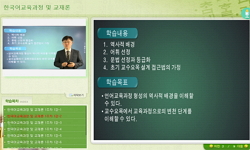The aim of this paper is to classify the dialogue act of user response utterances for the development of a dialogue system for Korean language education and to select what features are appropriate for efficiently discriminating such utterances. This p...
http://chineseinput.net/에서 pinyin(병음)방식으로 중국어를 변환할 수 있습니다.
변환된 중국어를 복사하여 사용하시면 됩니다.
- 中文 을 입력하시려면 zhongwen을 입력하시고 space를누르시면됩니다.
- 北京 을 입력하시려면 beijing을 입력하시고 space를 누르시면 됩니다.
https://www.riss.kr/link?id=T14738940
- 저자
-
발행사항
서울 : 연세대학교 대학원, 2018
-
학위논문사항
학위논문(석사) -- 연세대학교 대학원 , 언어정보학 협동과정 전산언어학 전공 , 2018.2
-
발행연도
2018
-
작성언어
한국어
-
주제어
대화 시스템 ; 대화형 에이전트 ; 대화형 인터페이스 ; 챗봇 ; 화행 자동 분류 ; 화행 ; 화행 판별 자질 ; 문맥 자질 ; 문장 자질 ; 한국어 교육 ; dialogue act ; speech act ; dialogue system ; conversational agent ; chat bot ; conversational corpus ; discrimination features ; context features ; sentence features ; Korean language education
-
발행국(도시)
서울
-
기타서명
A study on features of dialogue act classification for Korean language education dialogue system
-
형태사항
vi, 120 p. : 삽화 ; 26 cm
-
일반주기명
지도교수: 김한샘
-
UCI식별코드
I804:11046-000000515964
- 소장기관
-
0
상세조회 -
0
다운로드
부가정보
다국어 초록 (Multilingual Abstract)
The aim of this paper is to classify the dialogue act of user response
utterances for the development of a dialogue system for Korean language
education and to select what features are appropriate for efficiently
discriminating such utterances. This paper proposes a dialogue tag set that
classifies the learner's utterance intent to develop a chat bot dialog system
designed to enable Korean learners to practice Korean conversation. In order to
classify the utterances automatically according to these tag set, I examine
what features are suitable for the conversation system made for Korean
education among the discriminant features used in the previous research.
For this purpose, a corpus for Korean language education was collected to
annotate the discriminant features and dialogue act. Based on the annotated
corpus, we selected the dialogue act tags that can be used in the dialogue
system for Korean language education. Rather than the traditional linguistic
works, the discriminant features were chosen for practical use in the dialogue
system for practicing Korean conversation. In case of the discriminant
features, the features that can be commonly used in both rules base – d automatic
classification and statistics-based automatic classification are selected and
analyzed.
The first chapter presents the purpose and background of this study. After
examining the discussions related to the speech, second chapter the scholarly
works on the automatic classification method. Furthermore, this chapter analyze
the corpus used in the previous research after summarizing the discriminant
features used in the study. The third chapter provides the design and
collection of dialog corpus to be used in the dialogue system for Korean language education. The fourth chapter analyses the collected response speech
data. The conclusion part gives the results of this study and future issues.
국문 초록 (Abstract)
본고의 연구 주제는 한국어 교육 목적의 대화 시스템 개발을 위하여 사용자 응답 발화의 화행을 분류하고, 이러한 화행을 효율적으로 판별하는 데 적합한 자질이 무엇인지를 선별하는 것이...
본고의 연구 주제는 한국어 교육 목적의 대화 시스템 개발을 위하여 사용자 응답 발화의 화행을 분류하고, 이러한 화행을 효율적으로 판별하는 데 적합한 자질이 무엇인지를 선별하는 것이다. 본고는 한국어 학습자들이 한국어 회화를 연습할 수 있도록 고안된 챗봇 대화 시스템에 입력된 학습자의 발화 의도를 파악하고 분류하는 화행 표지 체계를 제안한다. 또한, 이러한 화행 표지에 맞춰 발화를 자동으로 분류하기 위하여 기존에 화행 자동 분류 연구에서 이용된 화행 판별 자질 중 한국어 교육 목적 대화 시스템에 적합한 자질이 무엇인지 검토한다.
이를 위하여 한국어 교육용 대화 말뭉치를 구축하여 화행과 화행 판별 자질을 주석하였다. 주석된 말뭉치를 바탕으로 한국어 교육 목적의 대화 시스템에서 활용 가능한 화행 표지를 선정하였고, 화행 판별 자질과 화행 간의 연관도를 검토하여 각 화행별로 유의미한 화행 판별 자질을 추출하였다. 화행 표지는 전통적인 언어학에서의 화행과는 별개로 한국어 회화를 연습하기 위한 대화 시스템에서 실용적으로 활용할 수 있는 표지를 선택하였다. 화행 판별 자질의 경우 규칙 기반 자동 분류 모델과 통계 기반 자동 분류 모두에서 공통으로 활용할 수 있는 자질을 선정하여 그 특성을 분석하였다.
서론에서는 본 연구의 목적과 배경, 의의에 대해서 논한다. 관련 연구에서는 화행과 관련된 논의를 살펴본 후, 화행 자동 분류 방식에 대한 연구의 흐름에 대해서 탐구하면서 이러한 연구에서 활용된 화행 판별자질에 대하여 정리한 뒤 기존의 연구에서 활용된 말뭉치에 대하여 분석한다. 3장에서는 한국어 교육 목적의 대화 시스템에서 사용될 대화 말뭉치의 설계와 구축에 대하여 논의하고 4장에서는 수집된 응답 발화 데이터를 분석하여 화행별로 유의미한 화행 판별 자질을 선별한다. 결론에서는 본 연구의 성과와 추후 과제에 대하여 논한다.












